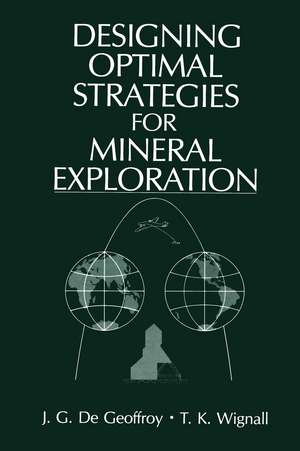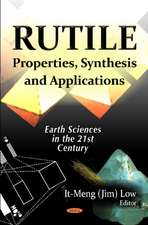Designing Optimal Strategies for Mineral Exploration
Autor J.G. De Geoffroy, T.K. Wignallen Limba Engleză Paperback – 16 feb 2012
Preț: 643.84 lei
Preț vechi: 757.46 lei
-15% Nou
Puncte Express: 966
Preț estimativ în valută:
123.20€ • 128.63$ • 101.96£
123.20€ • 128.63$ • 101.96£
Carte tipărită la comandă
Livrare economică 05-19 aprilie
Preluare comenzi: 021 569.72.76
Specificații
ISBN-13: 9781468412321
ISBN-10: 1468412329
Pagini: 384
Ilustrații: 380 p.
Dimensiuni: 152 x 229 x 20 mm
Greutate: 0.51 kg
Ediția:Softcover reprint of the original 1st ed. 1985
Editura: Springer Us
Colecția Springer
Locul publicării:New York, NY, United States
ISBN-10: 1468412329
Pagini: 384
Ilustrații: 380 p.
Dimensiuni: 152 x 229 x 20 mm
Greutate: 0.51 kg
Ediția:Softcover reprint of the original 1st ed. 1985
Editura: Springer Us
Colecția Springer
Locul publicării:New York, NY, United States
Public țintă
ResearchCuprins
One Optimizing Mineral Exploration.- 1.1. General Statement.- 1.2. The Mitigation of Uncertainty and Risk in Mineral Exploration.- 1.3. Conclusion: Scope of the Book.- References and Selected Readings.- Two Evaluation of the Probability of Detection of Mineral Deposits.- 2.1. The Detection Process.- 2.2. Geometric Considerations Involved in the Detection of Mineral Deposits.- 2.3. The Theory of Geometric Probabilities as a Foundation for the Evaluation of the Probability of Detection of Mineral Deposits.- 2.4. Evaluation of the Probability of Target Detection by Airborne Geophysical Surveys.- 2.5. Evaluation of the Probability of Target Detection by Ground Geophysical Surveys and Drilling Programs.- 2.6. Probability of equential Detection of Ore Deposits.- References and Selected Readings.- Three Cost of Detection.- 3.1. General Statement.- 3.2. Costing and Cost Estimates.- 3.3. Cost Functions.- 3.4. Tabulation of Cost Functions.- References and Selected Readings.- Four Optimizing Ore Detection.- 4.1. General Statement.- 4.2. Basic Theory of Optimization.- 4.3. Methodology of Optimization.- 4.4. Application of Optimization Theory to Ore Detection.- References and Selected Readings.- Five Application of the Optimization Methodology to the Search for Six Types of Ore Deposits in North America.- 5.1. General Statement.- 5.2. Construction of a Database.- 5.3. Data Processing.- 5.4. Computation of Detection Probabilities.- 5.5. Design of Three Strategies for the Detection of Six Types of Ore Deposits in North America.- References and Selected Readings.- Six Designing Optimized Field Programs for the Detection of Porphyry-Cu-Mo Deposits of the North American Cordillera Belt.- 6.1. General Geological Background.- 6.2. Field Detection Methodology.- 6.3. Statistical Modeling ofthe Geometric Parameters of Porphyry-Cu-Mo Deposits and their Associated Pyritic Halos.- 6.4. Construction and Organization of Detection Probability Tables.- 6.5. Designing Three Strategies for the Search for Porphyry-Cu-Mo Deposits in the North American Cordillera Belt.- References and Selected Readings.- Seven Optimized Search for Four Types of Contact Metasomatic Deposits of the North American Cordillera Belt.- 7.1. General Geological Background.- 7.2. Field Detection Methodology.- 7.3. Probability of Detection of Cu-Fe Contact Metasomatic Deposits.- 7.4. Probability of Detection of Pb-Zn-Cu-Ag Contact Metasomatic Deposits.- 7.5. Probability of Detection of Cu-Mo-Au Contact Metasomatic Deposits.- 7.6. Probability of Detection of W-Mo Contact Metasomatic Deposits.- 7.7. Designing Three Strategies for the Detection of Four Types of Contact Metasomatic Deposits of the North American Cordillera.- References and Selected Readings.- Eight Detection of Ni-Cu Ultramafic Deposits of the North American Shield by Optimized Geophysical Surveys and Drilling Programs.- 8.1. General Geological Background.- 8.2. Field Detection Methodology.- 8.3. Statistical Modeling of Geometric Parameters of Ni-Cu Deposits.- 8.4. Construction and Organization of Detection Probability Tables.- 8.5. Designing Three Strategies for the Detection of Ni-Cu Deposits of the North American Shield.- 8.6. Detection Probability and Optimization Tables.- References and Selected Readings.- Nine Optimized Airborne and Ground Search for Volcanogenic Massive Sulfide Deposits of the North American Shield and Cordillera Belt.- 9.1. General Statement.- 9.2. General Geological Background: Volcanogenic Sulfide Deposits of the North American Shield.- 9.3. Field Detection Methodology.- 9.4. Statistical Modeling of Geometric Parameters of Shield.- Volcanogenic Sulfide Deposits.- 9.5. Construction and Organization of Detection Probability Tables for Shield Volcanogenic Sulfide Deposits.- 9.6. Design of Three Strategies for the Detection of Shield Volcanogenic Sulfide Deposits.- 9.7. Detection Probability and Optimization Tables for Shield.- Volcanogenic Sulfide Deposits.- 9.8. Geological Synopsis for Volcanogenic Sulfide Deposits of the North American Cordillera Belt.- 9.9. Statistical Modeling of Geometric Parameters of Cordillera Volcanogenic Sulfide Deposits.- 9.10. Construction and Organization of Detection Probability Tables for Cordillera Volcanogenic Sulfide Deposits.- 9.11. Designing Three Strategies for the Detection of Cordillera Volcanogenic Sulfide Deposits.- 9.12. Detection Probability and Optimization Tables for Cordillera Volcanogenic Sulfide Deposits.- References and Selected Readings.- Ten Designing Optimized Field Programs for the Detection of Mississippi Valley-Type Pb-Zn Deposits of the North American Arctic Paleozoic Platform.- 10.1. General Geological Background.- 10.2. Field Detection Methodology.- 10.3. Statistical Modeling of the Geometric Parameters of North.- American Arctic Deposits.- 10.4. Construction and Organization of Detection Probability Tables.- 10.5. Designing Three Strategies for the Detection of Arctic Mississippi Valley-Type Pb—Zn Deposits.- 10.6. Detection Probability and Optimization Tables.- References and Selected Readings.- Eleven Detection of Vein-Gold Deposits of the North American Shield by Optimized Ground Programs.- 11.1. General Geological Background.- 11.2. Field Detection Methodology.- 11.3. Statistical Modeling of Geometric Parameters of Vein-Gold.- Deposits.- 11.4. Construction and Organization of Detection Probability Tables.-11.5. Design of Three Strategies for the Detection of Archean Vein-Gold Deposits of the North American Shield.- 11.6. Detection Probability and Optimization Tables.- References and Selected Readings.- Twelve Optimal Selection of Exploration Targets for Drill Testing.- 12.1. General Statement.- 12.2. Optimal Selection of Exploration Targets Based on Control Locations.- 12.3. Optimal Selection of Exploration Targets without Control Locations.- References and Selected Readings.- Conclusion.- Appendix: Measurement Conversion Table.- Author Index.- Listed Journals.










